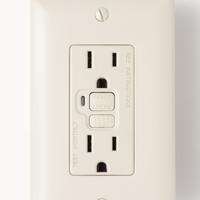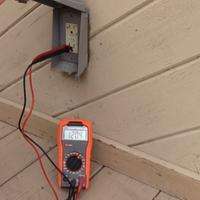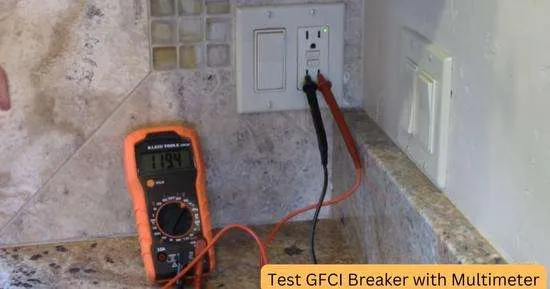A GFCI circuit breaker saves you from electrocution due to any fault in the ground connection. That’s why you should timely test your GFCI breaker or outlet. You can test a GFCI outlet with a multimeter or receptacle tester. In this post, we’ll learn a GFCI circuit, how it works, and how to test a GFCI breaker with a multimeter.
Table of Contents
ToggleHow GFCI circuit work?
GFCI means ground fault circuit interrupter. A GFCI is an advanced circuit for circuit breakers, outlets, and portable circuits.
When the ground circuit is faulty, an accidental human connection with a live circuit can disrupt the amperage and voltage of the circuit. A GFCI breaker detects the decrease in current, even in milliamps, and turns off the power supply.
A GFCI detects a decrease in the current supply, even 5 milliamps, reacts within 1/10 of a second, turns off the breaker, and disconnects the power supply. The main purpose of a GFCI breaker or circuit is to prevent a human from electric shocks by turning the power supply off when the circuit breaker detects a sudden change in current due to an in-ground or short circuit.
When the ground connection in a circuit is faulty or unavailable, and a human touches the live wire, current passes through his body instead of the ground wire. If a human touches a live circuit, the ground connection provides a path for the current to return to the ground(earth) without seriously harming a living being.
How to test a GFCI breaker with the multimeter
- Set your multimeter to AC voltage at 600V range. Connect multimeter probes to live and neutral wires in the circuit breaker or receptacle.
- If the GFCI circuit is fine, the multimeter should read the exact voltage supply, such as 120 or 240V.
- Also, check if the wiring is done correctly and if there is any loose connection.
- Test the START and RESET buttons. The breaker gets off when you press the START button, and all connected appliances go off.
- Pressing the RESET button will turn on the circuit again.
Follow the complete step-by-step guide:
Test Voltage in the GFCI breaker
We also measure voltage in the GFCI receptacle to configure any fault related to the power supply.
Set your multimeter to AC voltage. Insert the black probe in the receptacle’s single upper or lower terminal(ground). Insert the red probe in the rest of both holes(terminals) of the receptacle, one by one.
The multimeter will show you the voltage when the red probe is attached to the live wire in the outlet. If your power supply is divided into two phases (live wires), then the multimeter should read around 120V. In the case of a single power supply connection, your multimeter should read around 240V.
The ground wiring is faulty if your multimeter reads quite low voltage than 120 or 240V(power supply).
Inspect for Correct wiring and Buttons
A GFCI outlet usually has two receptacles and buttons in the center:
-
Test
-
Reset
To test the GFCI outlet, press the START button, and the circuit will be powered off, and any appliance connected to the receptacle will be powered off. In this way, you can check if your gfci receptacle is working fine or not.
The RESET button turns on the circuit again, and the current passes.
If you unscrew the GFCI outlet, the upper bolts on both sides of the receptacle’s back are for line wires(live and neutral) terminals. A line wiring is a set of wires that carries power from the power supply to your outlet circuit.
However, the lower terminals on opposite sides on the back of the gfci outlet are for load wires (live and neutral). Load wires take power from the line wires and supply it to the other circuits.
However, the ground connection is the most important part of a GFCI and is available at the bottom center.
With this rule, you can also identify wires: the top terminals are for line wires(carrying current toward the gfci outlet), and the lower terminals are for the load wires (carrying away from the outlet). The top and bottom terminals at the right are for the live wires(from both line and load).
And the top and bottom terminals are for neutral wires going from line to load (top to bottom).
You have to visually check if the line, load, and ground wires are installed in the right location. Make sure that there is no loose wire in the terminals.
A multimeter is an excellent electrical measurement tool that we’ll use to test a GFCI breaker by checking voltage and amperage in the circuit.
A GFCI circuit breaker has a trip button to turn the power on and off. Same as a gfci outlet, a gfci has the same wiring terminals as a receptacle. Line wires are connected in the top left and right terminals. You have to test the voltage in the live and neutral wires of the breaker. The breaker works well if the voltage (around 120 or 240) is fine.
Frequently Asked Questions
How do you know if a circuit breaker is bad?
To know if a breaker is bad, turn it off. If the circuit breaker is fine, every circuit controlled by the breaker should be powered off. If the circuit is still functioning, that means the breaker is bad.
Also, check the voltage in the breaker. If the voltage drops above the ideal range, the breaker is faulty because the current leaks.
How to test if an outlet is GFCI protected?
Press the START Button on the outlet; if it functions well, all the appliances connected to it should go off.
However, when you press the RESET button, the circuit breaker should turn on the power supply to all connected devices in the outlet.
By measuring the voltage in the outlet, you can test if the circuit breaker is fine.
How to test for a ground fault with a multimeter?
Set your multimeter to AC voltage and connect multimeter probes to the ground and neutral wires in the outlet or circuit. If the voltage exceeds zero, the current leaks through the ground wire.
Also, check the voltage in the live and neutral wire; if the voltage is quite less than the voltage supply, the ground connection is faulty.
Conclusion
Hence a properly grounded GFCI circuit should be installed and checked after some time. If a GFCI outlet is finely working(properly grounded), it can save you from life risks. Work as a ground fault interrupter; your GFCI breaker or outlet should be wired correctly. Also, check if the GFCI circuit receives maximum voltage and if the current is leaking.
Follow the step-by-step guide above to test your gfci outlet. If you still have queries, ask us in the comments.
Related Guides:






